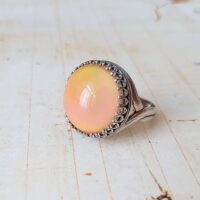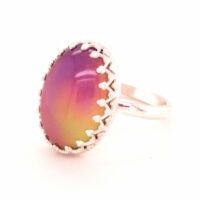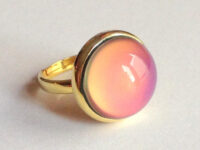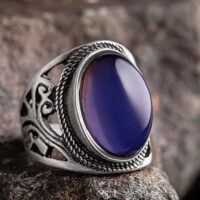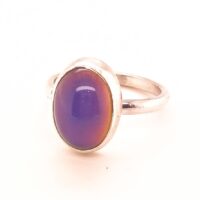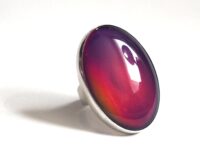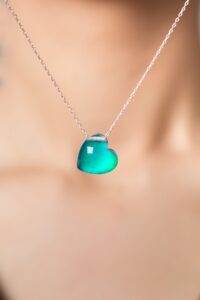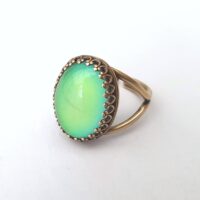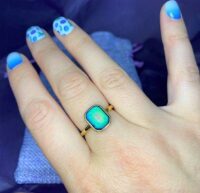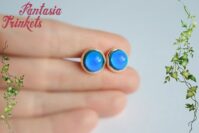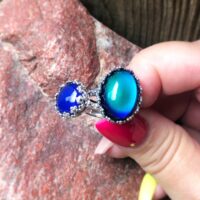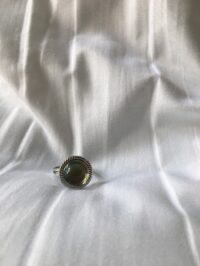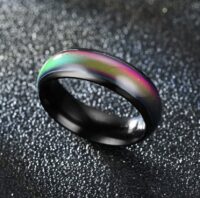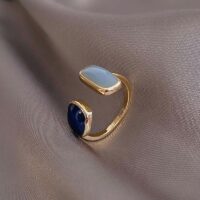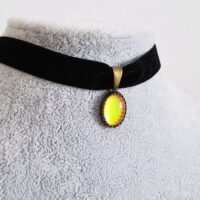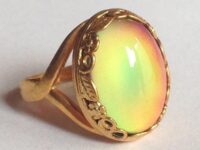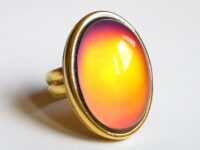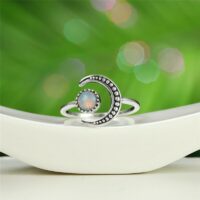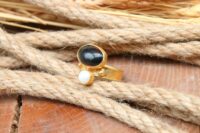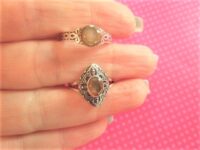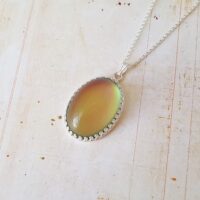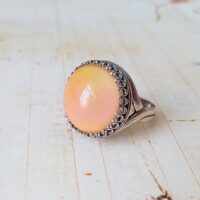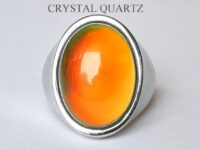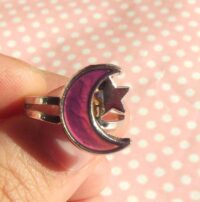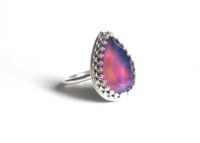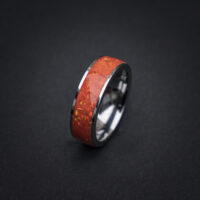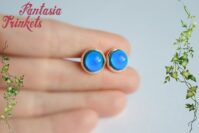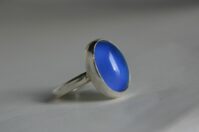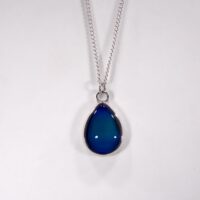Imagine a piece of jewelry that changes color, reflecting your emotions and mood swings. Sounds like something straight out of a sci-fi movie, right? But it’s not! Welcome to the fascinating world of Mood Rings.
Invented in the groovy era of the 1970s, mood rings quickly became a cultural phenomenon, a fashion statement, and a conversation starter. These captivating accessories, with their vibrant hues shifting from deep blues to fiery reds, have intrigued and fascinated people for decades.
But what if I told you that the magic of mood rings is not just a marketing gimmick? It’s a fascinating blend of science, psychology, and art. The secret lies in the thermochromic liquid crystals, a special substance that changes color with temperature variations.
Mood Ring Color Meanings
BLACK Mood RING
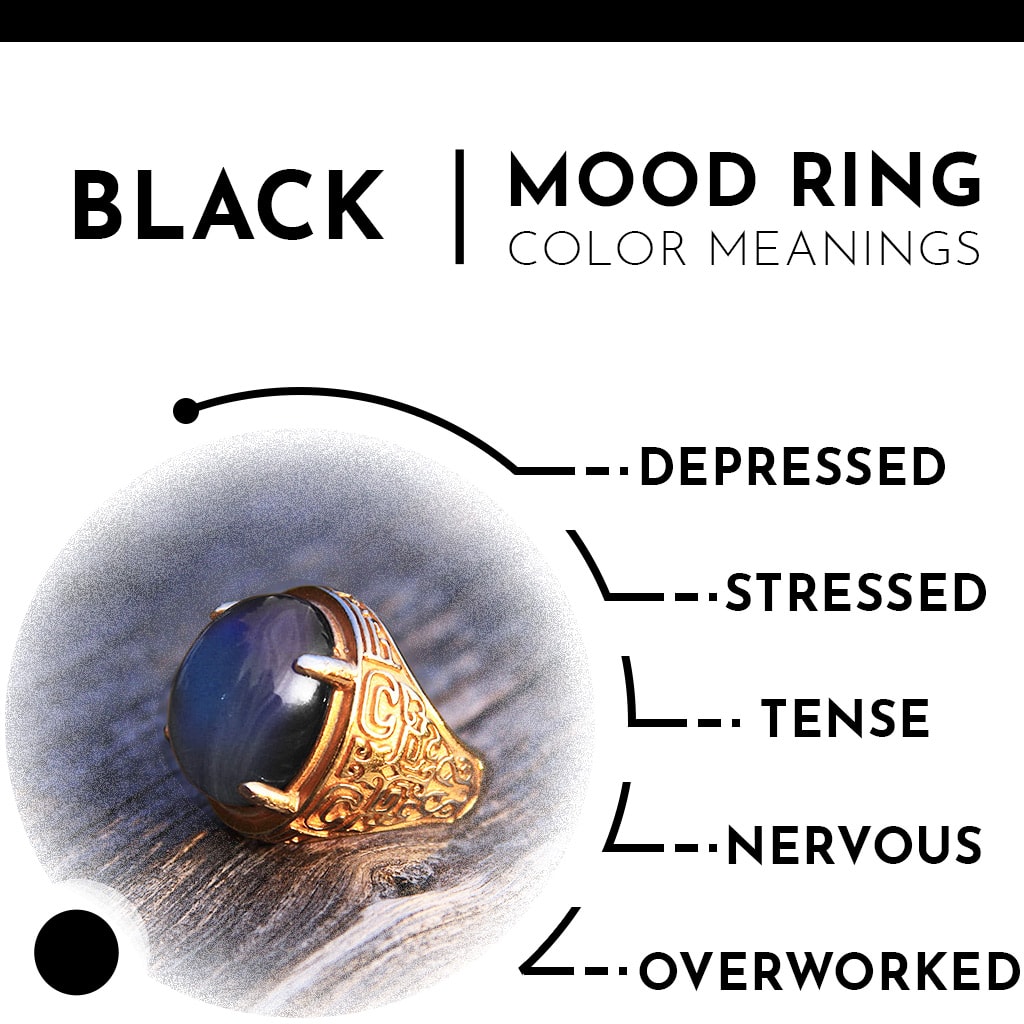
In the world of mood rings, each color holds a unique significance, a secret language that supposedly reflects our inner emotional state. Among these, the black mood ring stands out with its dark allure and enigmatic meanings. But what does a black mood ring truly signify? Let’s delve into the intriguing world of black mood rings and unravel their mysteries.
The Allure of the Black Mood Ring
Black, the color of the night sky, the color of mystery and the unknown, holds a unique place in our psyche. In the context of mood rings, black is often associated with intense emotions and powerful states of mind. When a mood ring turns black, it’s as if it’s mirroring the depths of our subconscious, reflecting the stormy seas and calm pools hidden within us.
Black Mood Ring Color Meanings
The color black in a mood ring is associated with a range of meanings, each adding a layer to its enigma. Here are some of the common interpretations:
- Sophistication: Black is often associated with elegance and sophistication. It’s the color of the little black dress, the sleek black car, the ink of a finely crafted calligraphy. When a mood ring turns black, it might be reflecting a state of refined sophistication.
- Stressed, Overworked, and Depressed: Black can also signify negative emotions. It can indicate that the wearer is feeling stressed, overworked, or depressed. It’s the color of a mind burdened by worries, a heart heavy with sorrow.
- Fear and Angst: Fear and angst, those intense emotions that can grip our hearts, are also associated with the color black. A black mood ring might be reflecting these powerful emotions, serving as a silent scream in the darkness.
- Serious and Intense: Black is the color of seriousness and intensity. It’s the color of a focused mind, a determined spirit, a soul that’s not afraid to delve into the depths.
- Stormy: Just like a stormy night, a black mood ring can signify turmoil and chaos. It’s the color of a mind in the midst of a storm, wrestling with tumultuous thoughts and emotions.
- Death, Evil, and Mystery: In many cultures, black is associated with death, evil, and mystery. While these might seem like dark and ominous associations, they also add to the allure of the black mood ring, making it a symbol of the unknown, the mysterious, the forbidden.
- Power: Last but not least, black is the color of power. It’s the color of authority, strength, and control. A black mood ring might be reflecting a state of empowerment, a sense of standing strong in the face of adversity.
PINK Mood RING

A Symbol of Love, Warmth, and Happiness
In the vibrant spectrum of mood ring colors, pink holds a special place. It’s a color that evokes feelings of warmth, love, and happiness. But what does a pink mood ring truly signify? Let’s explore the world of pink mood rings and uncover the meanings behind their rosy hues.
The Charm of the Pink Mood Ring
Pink, the color of blooming roses, cotton candy clouds, and blushing cheeks, is a color that warms our hearts. In the context of mood rings, pink is often associated with positive emotions and states of mind. When a mood ring turns pink, it’s as if it’s reflecting the rosy glow of our inner world, mirroring the warmth and love within us.
Pink Mood Ring Color Meanings
The color pink in a mood ring is associated with a range of meanings, each adding a layer to its charm. Here are some of the common interpretations:
- Loving and Affectionate: Pink is often associated with love and affection. It’s the color of a heart full of love, a soul brimming with affection. When a mood ring turns pink, it might be reflecting a state of love and affection.
- Romance and Infatuation: Pink can also signify romance and infatuation. It’s the color of a heart in the throes of a crush, a mind filled with romantic thoughts. A pink mood ring might be reflecting these sweet emotions, serving as a silent love letter.
- Warm and Very Happy: Warmth and happiness, those comforting emotions that fill our hearts with joy, are also associated with the color pink. A pink mood ring might be reflecting these positive emotions, serving as a beacon of happiness.
- Beauty: Pink is the color of beauty. It’s the color of a beautiful mind, a beautiful heart, a beautiful soul. A pink mood ring might be reflecting a state of appreciation for beauty, both within and around us.
- Friendship: Just like the pinky promise, a pink mood ring can signify friendship. It’s the color of camaraderie, of shared laughter and shared secrets. A pink mood ring might be reflecting a state of friendship, a bond that warms the heart.
- Curiosity and Sensitivity: Pink is also associated with curiosity and sensitivity. It’s the color of a curious mind, a sensitive heart. A pink mood ring might be reflecting these traits, serving as a symbol of our innate curiosity and sensitivity.
PURPLE Mood RING
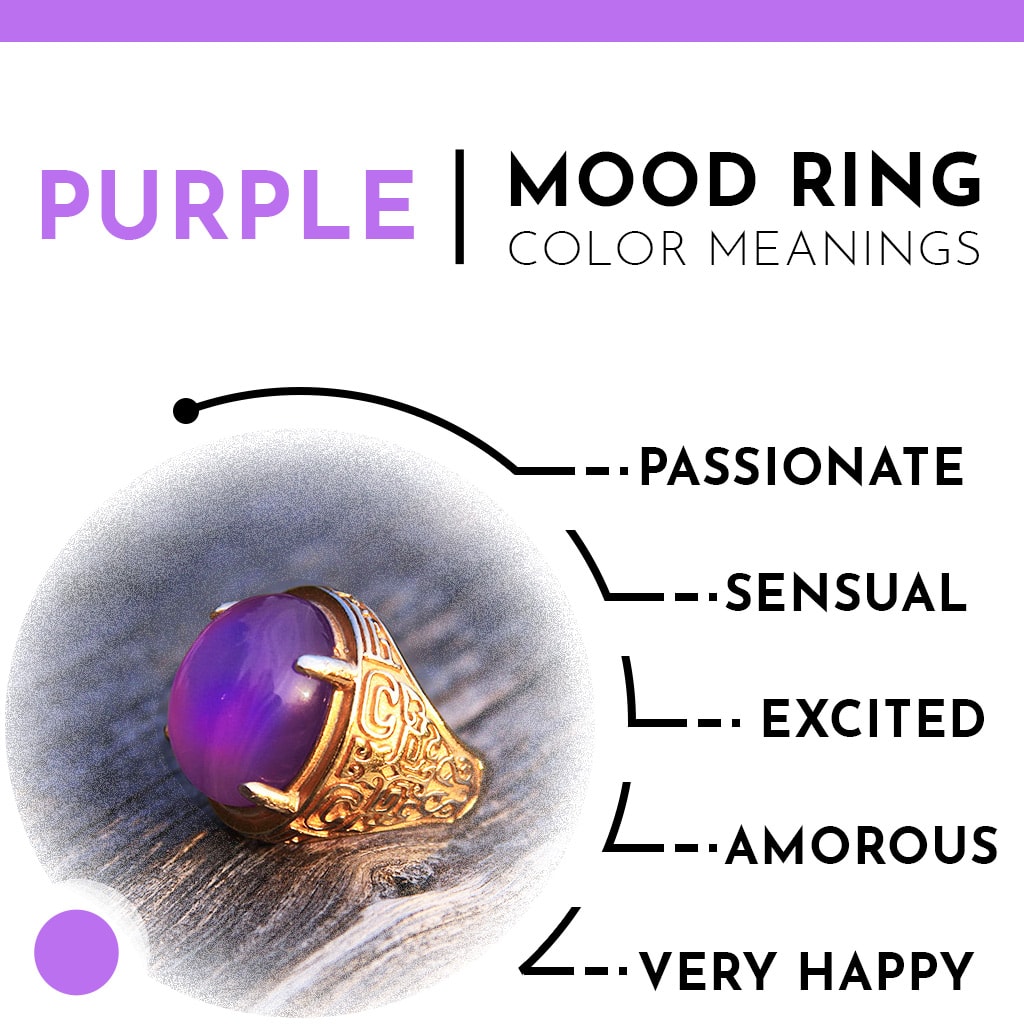
A Symbol of Love, Wisdom, and Magic
Among the spectrum of mood ring colors, purple stands out with its rich and royal hues. It’s a color that evokes feelings of love, wisdom, and a touch of magic. But what does a purple mood ring truly signify? Let’s delve into the world of purple mood rings and uncover the meanings behind their regal colors.
The Majesty of the Purple Mood Ring
Purple, the color of twilight skies, royal robes, and blooming lavender, is a color that captivates our senses. In the context of mood rings, purple is often associated with deep emotions and profound states of mind. When a mood ring turns purple, it’s as if it’s reflecting the depth and richness of our inner world, mirroring the majesty and mystery within us.
Purple Mood Ring Color Meanings
The color purple in a mood ring is associated with a range of meanings, each adding a layer to its majesty. Here are some of the common interpretations:
- Love and Romance: Purple is often associated with love and romance. It’s the color of a heart full of love, a mind filled with romantic thoughts. When a mood ring turns purple, it might be reflecting a state of love and romance.
- Moody and Passionate: Purple can also signify moodiness and passion. It’s the color of a heart in the throes of intense emotions, a mind filled with passionate thoughts. A purple mood ring might be reflecting these deep emotions, serving as a silent testament to our inner turmoil and passion.
- Royalty, Luxury, and Dignity: Purple is the color of royalty, luxury, and dignity. It’s the color of a dignified spirit, a luxurious lifestyle, a royal demeanor. A purple mood ring might be reflecting these traits, serving as a symbol of our innate dignity and grace.
- Wisdom and Spirituality: Purple is also associated with wisdom and spirituality. It’s the color of a wise mind, a spiritual soul. A purple mood ring might be reflecting these traits, serving as a symbol of our inner wisdom and spiritual journey.
- Heat, Sensuality, and Amorous: Purple can also signify heat, sensuality, and amorous feelings. It’s the color of a heart aflame with desire, a mind filled with sensual thoughts. A purple mood ring might be reflecting these intense emotions, serving as a silent whisper of our inner desires.
- Dreamer, Vision, and Magic: Last but not least, purple is the color of dreamers, visionaries, and magic. It’s the color of a mind that dares to dream, a heart that dares to envision, a soul that believes in magic. A purple mood ring might be reflecting these traits, serving as a symbol of our dreams, visions, and the magic within us.
GREEN Mood RING
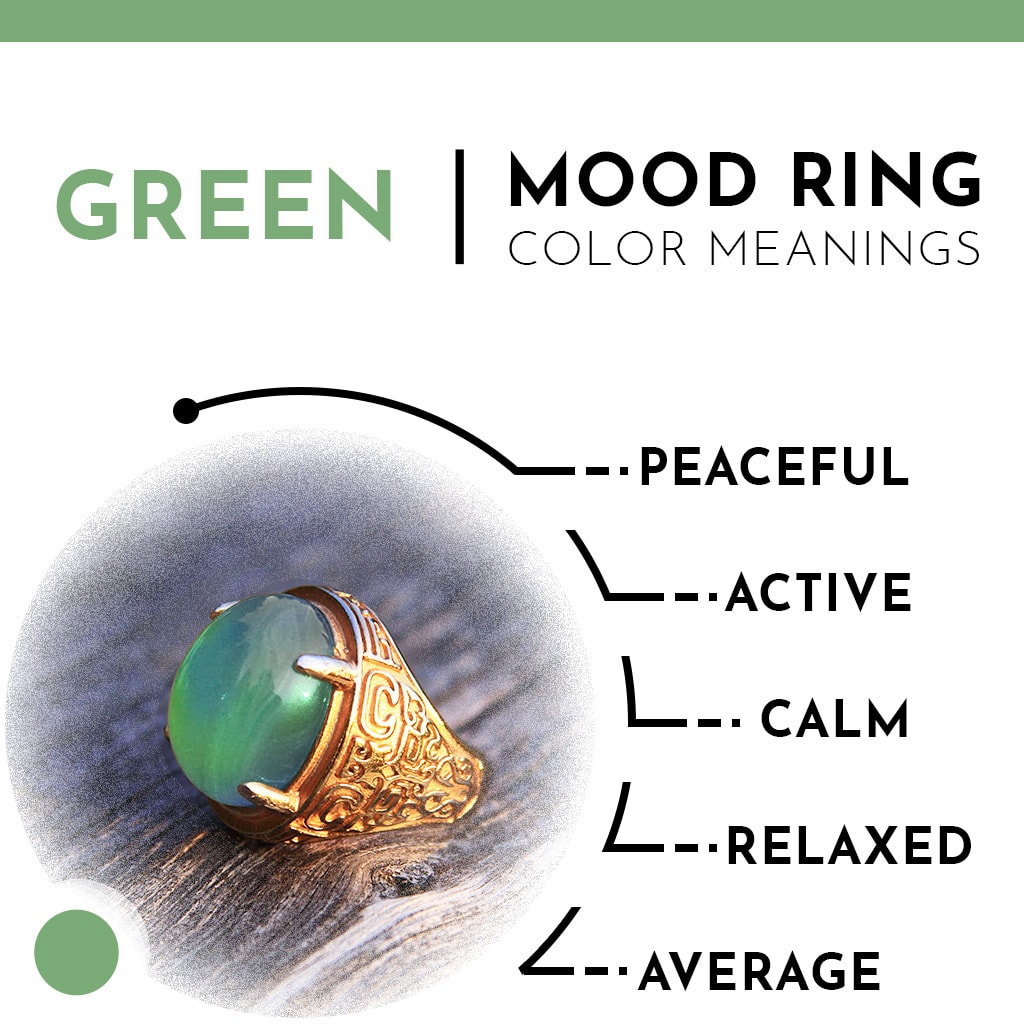
A Symbol of Mixed Emotions and Prosperity
In the vibrant palette of mood ring colors, green stands out with its soothing and lively hues. It’s a color that evokes feelings of mixed emotions, healing, and prosperity. But what does a green mood ring truly signify? Let’s explore the world of green mood rings and uncover the meanings behind their verdant colors.
The Vibrancy of the Green Mood Ring
Green, the color of lush forests, crisp dollar bills, and soothing aloe vera, is a color that resonates with life and vitality. In the context of mood rings, green is often associated with a range of emotions and states of mind. When a mood ring turns green, it’s as if it’s reflecting the vibrancy and complexity of our inner world, mirroring the ebb and flow of our emotions.
Green Mood Ring Color Meanings
The color green in a mood ring is associated with a range of meanings, each adding a layer to its vibrancy. Here are some of the common interpretations:
- Mixed Emotions and Restlessness: Green is often associated with mixed emotions and restlessness. It’s the color of a heart filled with conflicting feelings, a mind buzzing with thoughts. When a mood ring turns green, it might be reflecting a state of emotional turmoil and restlessness.
- Active and Irritated: Green can also signify activity and irritation. It’s the color of a body in motion, a mind agitated by annoyances. A green mood ring might be reflecting these states, serving as a silent testament to our inner dynamism and irritations.
- Distressed and Worried: Green is the color of distress and worry. It’s the color of a heart burdened by concerns, a mind filled with anxieties. A green mood ring might be reflecting these feelings, serving as a symbol of our inner worries and distress.
- Healing: On a positive note, green is also associated with healing. It’s the color of a body healing from illness, a heart mending from hurt. A green mood ring might be reflecting this state, serving as a symbol of our healing process.
- Prosperity: Last but not least, green is the color of money and prosperity. It’s the color of a wallet filled with crisp bills, a life filled with prosperity. A green mood ring might be reflecting these aspects, serving as a symbol of our financial status and aspirations.
LIGHT BLUE Mood RING
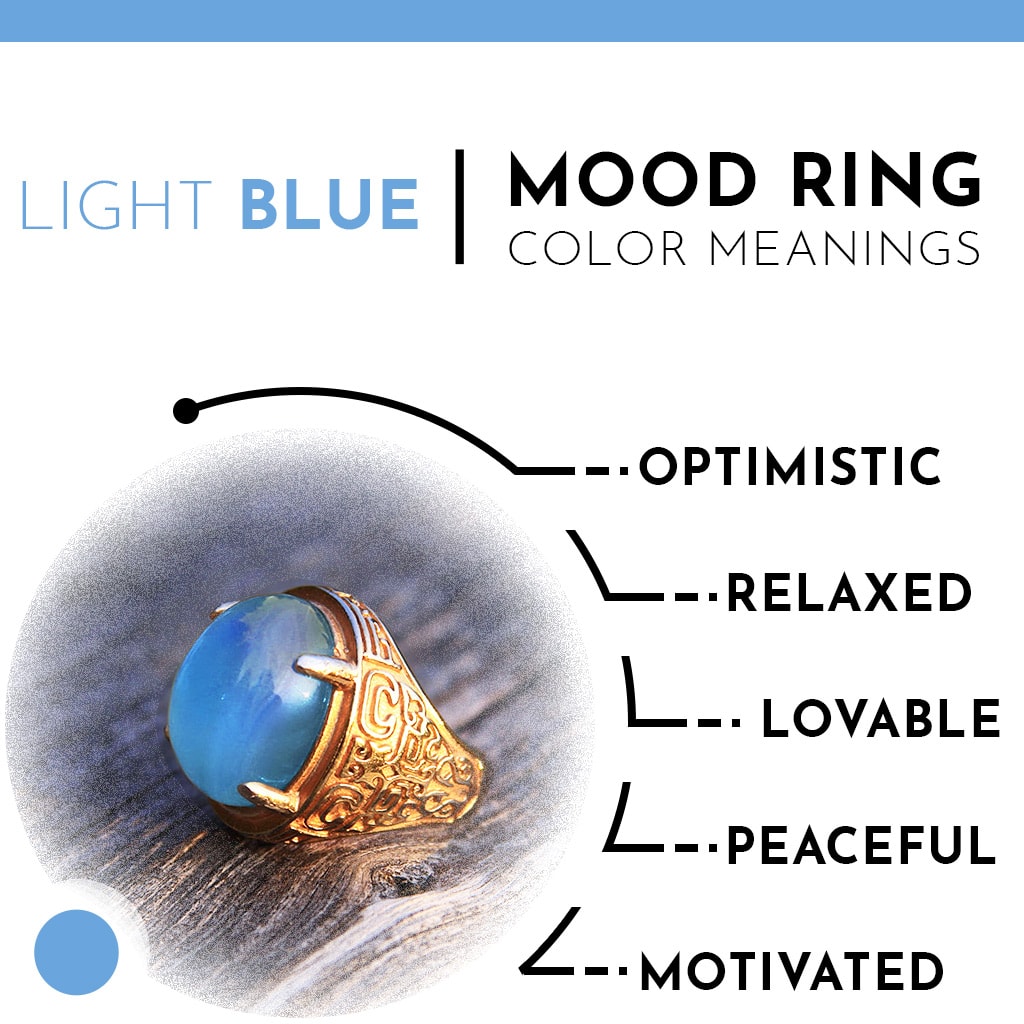
A Symbol of Peace, Relaxation, and Optimism
In the colorful world of mood rings, light blue stands out with its soothing and serene hues. It’s a color that evokes feelings of peace, relaxation, and optimism. But what does a light blue mood ring truly signify? Let’s delve into the world of light blue mood rings and uncover the meanings behind their tranquil colors.
The Serenity of the Light Blue Mood Ring
Light blue, the color of clear skies, tranquil seas, and morning dew, is a color that soothes our senses. In the context of mood rings, light blue is often associated with peaceful and positive states of mind. When a mood ring turns light blue, it’s as if it’s reflecting the tranquility and optimism of our inner world, mirroring the calm and serene waters within us.
Light Blue Mood Ring Color Meanings
The color light blue in a mood ring is associated with a range of meanings, each adding a layer to its serenity. Here are some of the common interpretations:
- Relaxed and Peaceful: Light blue is often associated with relaxation and peace. It’s the color of a body at rest, a mind at peace. When a mood ring turns light blue, it might be reflecting a state of relaxation and peace.
- Motivated and Optimistic: Light blue can also signify motivation and optimism. It’s the color of a heart filled with hope, a mind driven by motivation. A light blue mood ring might be reflecting these positive states, serving as a silent testament to our inner drive and optimism.
- Calm: Light blue is the color of calm. It’s the color of a heart free from worries, a mind free from turmoil. A light blue mood ring might be reflecting this state, serving as a symbol of our inner calm.
- Flirtatious: On a playful note, light blue can also be associated with flirtation. It’s the color of a heart fluttering with attraction, a mind filled with playful thoughts. A light blue mood ring might be reflecting this state, serving as a symbol of our flirtatious side.
GRAY Mood RING
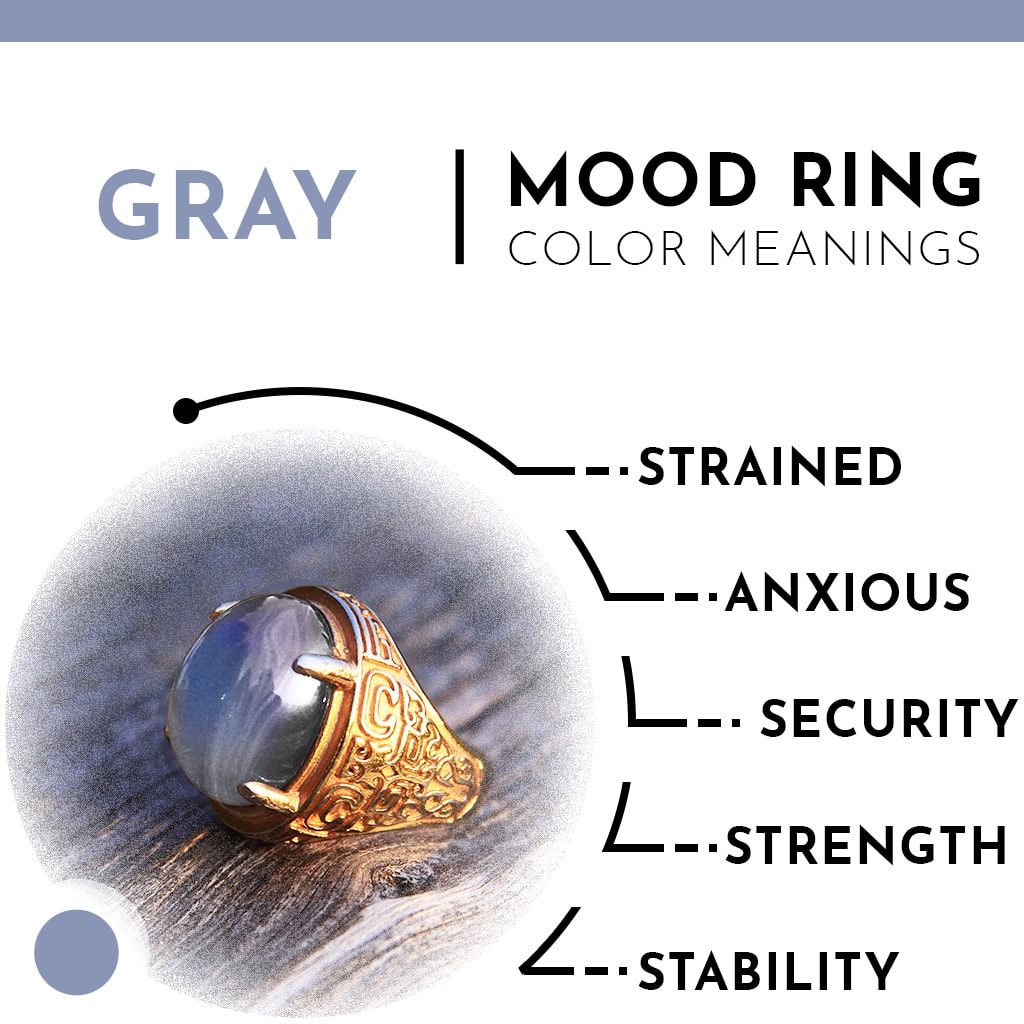
A Symbol of Stability, Strength, and Maturity
Among the spectrum of mood ring colors, gray stands out with its subtle and stable hues. It’s a color that evokes feelings of security, strength, and maturity. But what does a gray mood ring truly signify? Let’s explore the world of gray mood rings and uncover the meanings behind their understated colors.
The Stability of the Gray Mood Ring
Gray, the color of steel, stone, and overcast skies, is a color that resonates with stability and strength. In the context of mood rings, gray is often associated with secure and mature states of mind. When a mood ring turns gray, it’s as if it’s reflecting the stability and maturity of our inner world, mirroring the solid rock within us.
Gray Mood Ring Color Meanings
The color gray in a mood ring is associated with a range of meanings, each adding a layer to its stability. Here are some of the common interpretations:
- Security and Stability: Gray is often associated with security and stability. It’s the color of a heart at peace, a mind that’s secure. When a mood ring turns gray, it might be reflecting a state of security and stability.
- Strength and Authority: Gray can also signify strength and authority. It’s the color of a heart filled with courage, a mind that commands respect. A gray mood ring might be reflecting these states, serving as a silent testament to our inner strength and authority.
- Maturity: Gray is the color of maturity. It’s the color of a heart that’s experienced life, a mind that’s gained wisdom over the years. A gray mood ring might be reflecting this state, serving as a symbol of our maturity.
YELLOW Mood RING

A Symbol of Intellect, Energy, and Joy
In the vibrant array of mood ring colors, yellow shines brightly with its warm and energetic hues. It’s a color that evokes feelings of intellect, energy, and joy. But what does a yellow mood ring truly signify? Let’s delve into the world of yellow mood rings and uncover the meanings behind their sunny colors.
The Energy of the Yellow Mood Ring
Yellow, the color of sunshine, ripe lemons, and fields of sunflowers, is a color that radiates energy and warmth. In the context of mood rings, yellow is often associated with intellectual and joyful states of mind. When a mood ring turns yellow, it’s as if it’s reflecting the energy and joy of our inner world, mirroring the bright sunshine within us.
Yellow Mood Ring Color Meanings
The color yellow in a mood ring is associated with a range of meanings, each adding a layer to its energy. Here are some of the common interpretations:
- Intellect: Yellow is often associated with intellect. It’s the color of a mind buzzing with ideas, a heart filled with curiosity. When a mood ring turns yellow, it might be reflecting a state of intellectual engagement and curiosity.
- Energy and Joy: Yellow can also signify energy and joy. It’s the color of a heart filled with happiness, a mind buzzing with energy. A yellow mood ring might be reflecting these positive states, serving as a silent testament to our inner energy and joy.
- Warmth: Yellow is the color of warmth. It’s the color of a heart filled with kindness, a mind radiating positivity. A yellow mood ring might be reflecting this state, serving as a symbol of our inner warmth.
- Caution: On a more cautious note, yellow can also be associated with caution. It’s the color of a mind that’s alert, a heart that’s careful. A yellow mood ring might be reflecting this state, serving as a symbol of our caution and alertness.
- Friendless: Interestingly, yellow can also signify a state of feeling friendless. It’s the color of a heart longing for companionship, a mind seeking connection. A yellow mood ring might be reflecting this state, serving as a symbol of our longing for friendship.
WHITE Mood RING
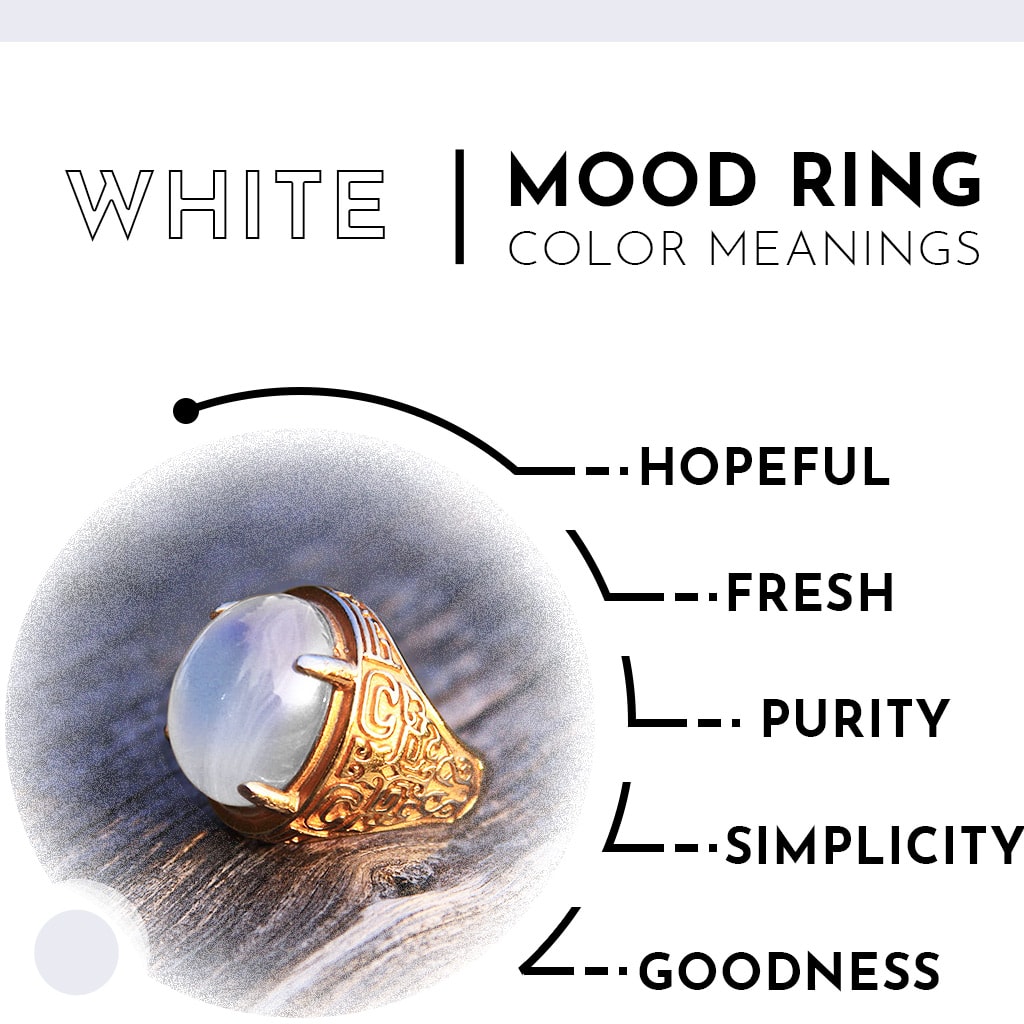
A Symbol of Hope, Purity, and Freshness
In the colorful spectrum of mood ring hues, white stands out with its pure and simple radiance. It’s a color that evokes feelings of hope, purity, and freshness. But what does a white mood ring truly signify? Let’s explore the world of white mood rings and uncover the meanings behind their pristine colors.
The Purity of the White Mood Ring
White, the color of fresh snow, fluffy clouds, and crisp linen, is a color that resonates with purity and simplicity. In the context of mood rings, white is often associated with hopeful and pure states of mind. When a mood ring turns white, it’s as if it’s reflecting the hope and purity of our inner world, mirroring the fresh snowfall within us.
White Mood Ring Color Meanings
The color white in a mood ring is associated with a range of meanings, each adding a layer to its purity. Here are some of the common interpretations:
- Hope and Light: White is often associated with hope and light. It’s the color of a heart filled with hope, a mind illuminated with positivity. When a mood ring turns white, it might be reflecting a state of hope and light.
- Purity and Goodness: White can also signify purity and goodness. It’s the color of a heart filled with good intentions, a mind that values purity. A white mood ring might be reflecting these positive states, serving as a silent testament to our inner purity and goodness.
- Simplicity: White is the color of simplicity. It’s the color of a heart that values the simple things in life, a mind that appreciates the beauty of simplicity. A white mood ring might be reflecting this state, serving as a symbol of our love for simplicity.
- Freshness: Last but not least, white is the color of freshness. It’s the color of a fresh start, a new beginning. A white mood ring might be reflecting this state, serving as a symbol of our readiness to embrace new beginnings and fresh opportunities.
BROWN Mood RING
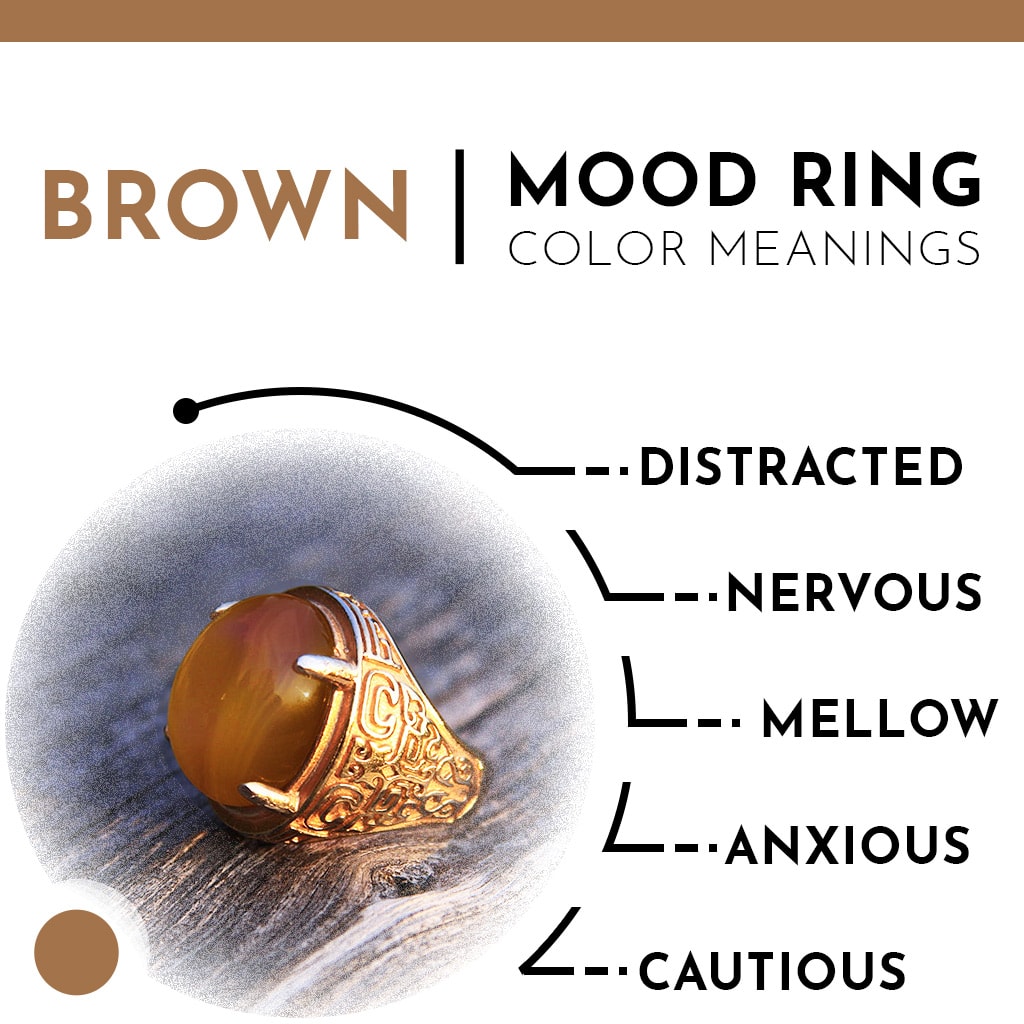
A Symbol of Nervousness and Mellow Vibes
In the diverse palette of mood ring colors, brown holds a unique place with its earthy and subdued hues. It’s a color that evokes feelings of caution, nervousness, and a mellow state of mind. But what does a brown mood ring truly signify? Let’s delve into the world of brown mood rings and uncover the meanings behind their earthy tones.
The Earthiness of the Brown Mood Ring
Brown, the color of rich soil, aged wood, and comforting coffee, is a color that resonates with groundedness and caution. In the context of mood rings, brown is often associated with cautious and nervous states of mind. When a mood ring turns brown, it’s as if it’s reflecting the cautious and mellow aspects of our inner world, mirroring the rich soil within us.
Brown Mood Ring Color Meanings
The color brown in a mood ring is associated with a range of meanings, each adding a layer to its earthiness. Here are some of the common interpretations:
- Nervous and Anxious: Brown is often associated with nervousness and anxiety. It’s the color of a heart filled with worry, a mind buzzing with anxious thoughts. When a mood ring turns brown, it might be reflecting a state of nervousness or anxiety.
- Cautious and Distracted: Brown can also signify caution and distraction. It’s the color of a mind that’s alert, a heart that’s cautious. A brown mood ring might be reflecting these states, serving as a silent testament to our inner caution and distractions.
- Mellow: On a softer note, brown is also associated with a mellow state of mind. It’s the color of a heart that’s calm, a mind that’s relaxed. A brown mood ring might be reflecting this state, serving as a symbol of our mellow vibes.
ORANGE Mood RING
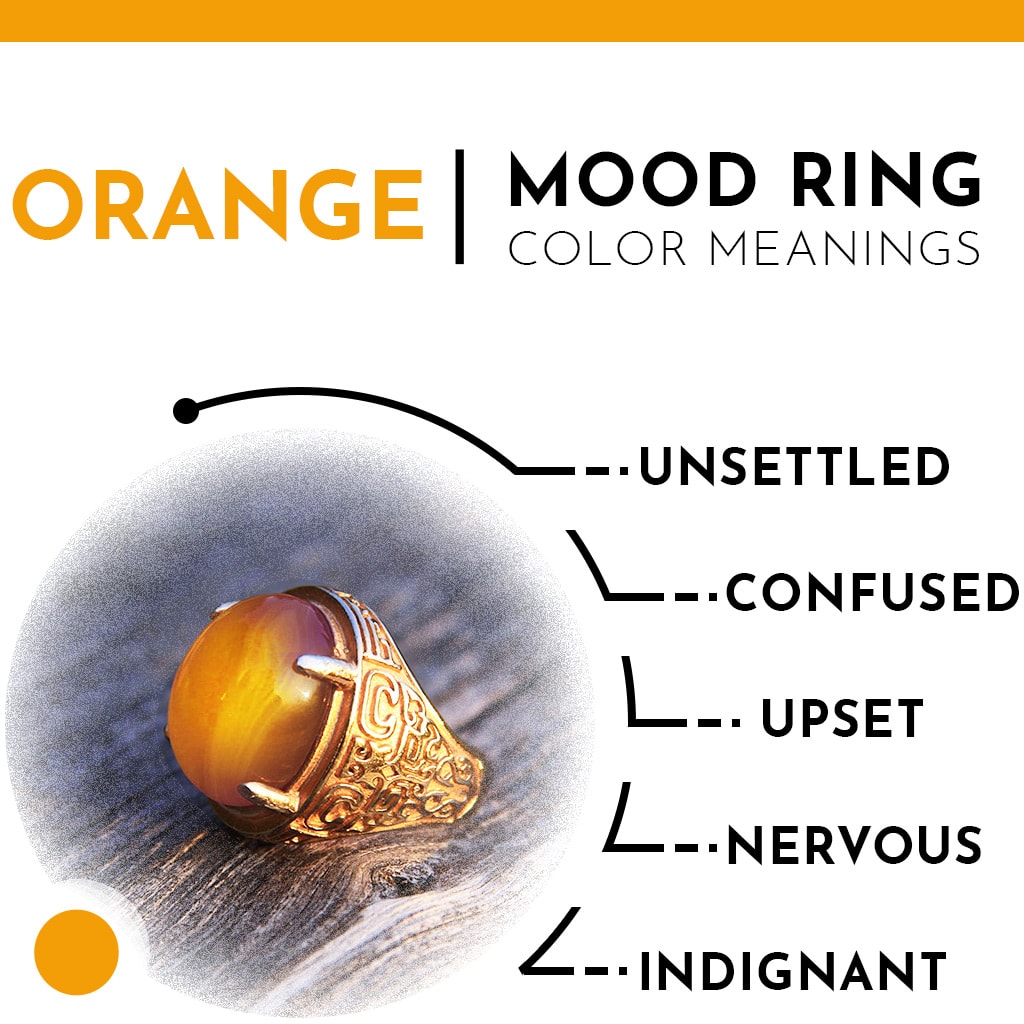
A Symbol of Challenge, Confusion, and Upset
In the vibrant array of mood ring colors, orange stands out with its fiery and intense hues. It’s a color that evokes feelings of challenge, confusion, and upset. But what does an orange mood ring truly signify? Let’s delve into the world of orange mood rings and uncover the meanings behind their fiery colors.
The Intensity of the Orange Mood Ring
Orange, the color of blazing sunsets, ripe pumpkins, and crackling fires, is a color that resonates with intensity and challenge. In the context of mood rings, orange is often associated with unsettled and challenging states of mind. When a mood ring turns orange, it’s as if it’s reflecting the fiery and intense aspects of our inner world, mirroring the blazing fire within us.
Orange Mood Ring Color Meanings
The color orange in a mood ring is associated with a range of meanings, each adding a layer to its intensity. Here are some of the common interpretations:
- Unsettled and Confused: Orange is often associated with feelings of being unsettled and confused. It’s the color of a heart filled with uncertainty, a mind buzzing with conflicting thoughts. When a mood ring turns orange, it might be reflecting a state of unsettlement or confusion.
- Indignant and Upset: Orange can also signify indignation and upset. It’s the color of a heart filled with righteous anger, a mind upset by injustice. An orange mood ring might be reflecting these states, serving as a silent testament to our inner indignation and upset.
- Challenged: On a more positive note, orange is also associated with feeling challenged. It’s the color of a heart that’s ready to take on challenges, a mind that’s not afraid to face obstacles. An orange mood ring might be reflecting this state, serving as a symbol of our readiness to take on challenges.
RED Mood RING
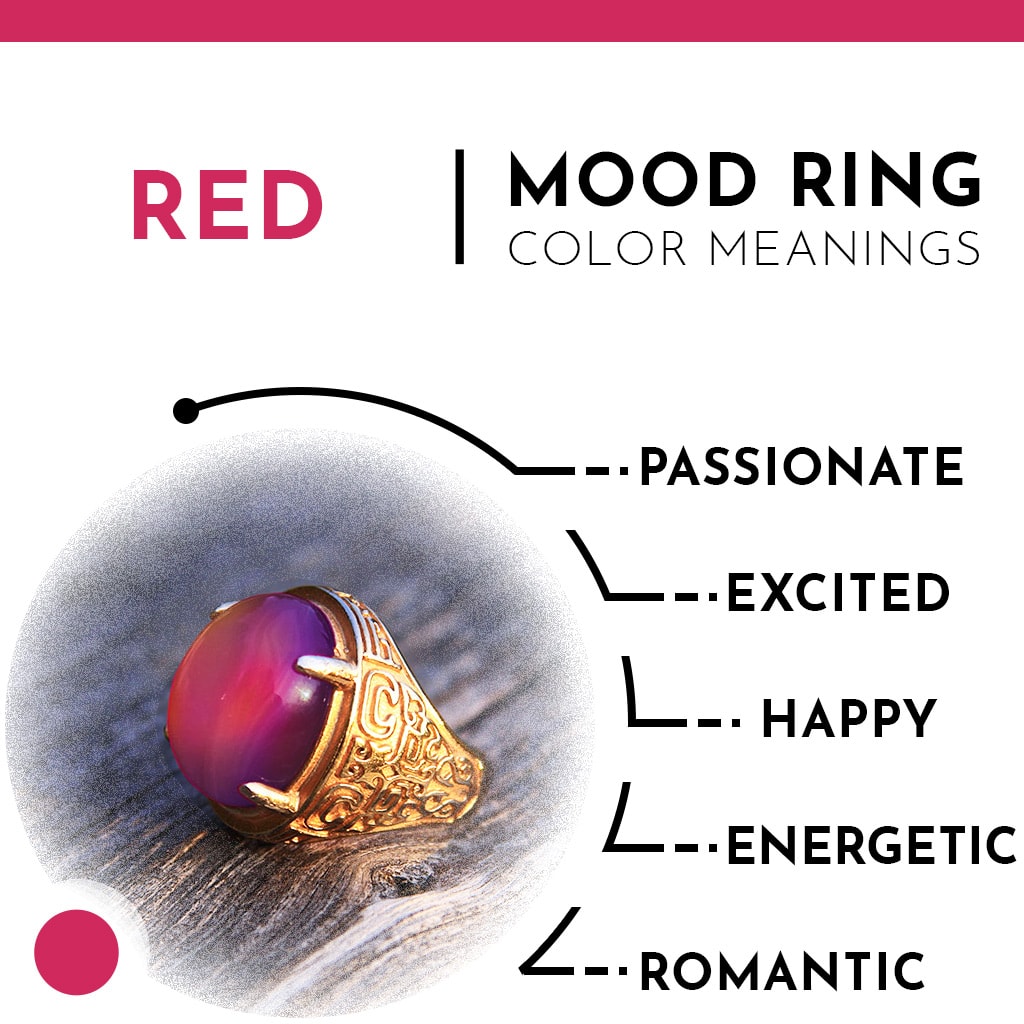
A Symbol of Passion, Energy, and Excitement
In the colorful spectrum of mood ring hues, red stands out with its vibrant and fiery tones. It’s a color that evokes feelings of passion, energy, and excitement. But what does a red mood ring truly signify? Let’s explore the world of red mood rings and uncover the meanings behind their fiery colors.
The Vibrancy of the Red Mood Ring
Red, the color of blazing fires, ripe cherries, and stunning sunsets, is a color that resonates with vibrancy and passion. In the context of mood rings, red is often associated with energetic and passionate states of mind. When a mood ring turns red, it’s as if it’s reflecting the fiery and vibrant aspects of our inner world, mirroring the blazing fire within us.
Red Mood Ring Color Meanings
The color red in a mood ring is associated with a range of meanings, each adding a layer to its vibrancy. Here are some of the common interpretations:
- Danger: Red is often associated with danger. It’s the color of a heart filled with fear, a mind alert to threats. When a mood ring turns red, it might be reflecting a state of alertness or fear.
- Passion and Romance: Red can also signify passion and romance. It’s the color of a heart filled with love, a mind consumed by romantic thoughts. A red mood ring might be reflecting these passionate states, serving as a silent testament to our inner passion and romance.
- Energetic and Excitement: Red is the color of energy and excitement. It’s the color of a heart filled with enthusiasm, a mind buzzing with excitement. A red mood ring might be reflecting this state, serving as a symbol of our energy and excitement.
DARK BLUE Mood RING
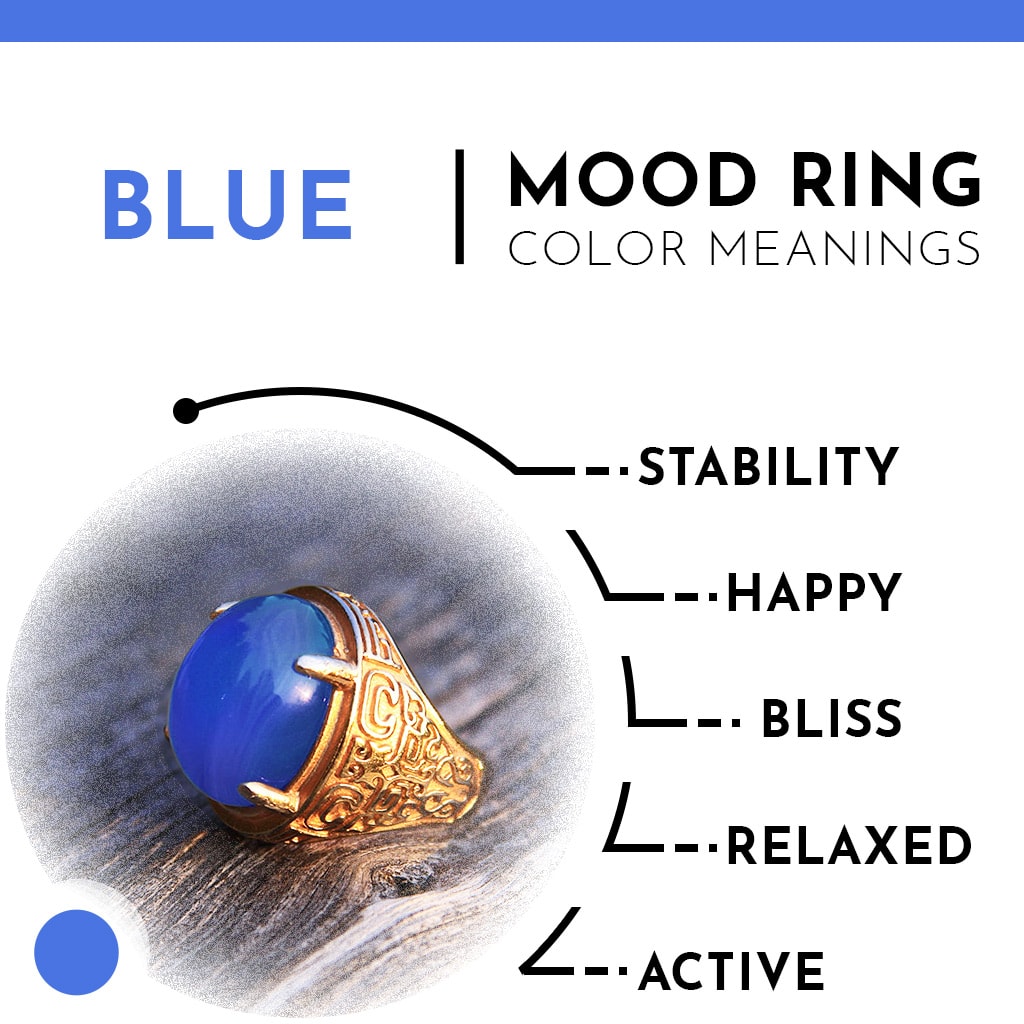
A Symbol of Happiness, Integrity, and Bliss
In the diverse palette of mood ring colors, dark blue stands out with its deep and serene hues. It’s a color that evokes feelings of happiness, integrity, and bliss. But what does a dark blue mood ring truly signify? Let’s delve into the world of dark blue mood rings and uncover the meanings behind their tranquil colors.
The Serenity of the Dark Blue Mood Ring
Dark blue, the color of midnight skies, deep oceans, and twilight shadows, is a color that resonates with tranquility and depth. In the context of mood rings, dark blue is often associated with happy and relaxed states of mind. When a mood ring turns dark blue, it’s as if it’s reflecting the deep and serene aspects of our inner world, mirroring the tranquil ocean within us.
Dark Blue Mood Ring Color Meanings
The color dark blue in a mood ring is associated with a range of meanings, each adding a layer to its serenity. Here are some of the common interpretations:
- Happy and Blissful: Dark blue is often associated with happiness and bliss. It’s the color of a heart filled with joy, a mind at peace. When a mood ring turns dark blue, it might be reflecting a state of happiness or bliss.
- Integrity and Sincerity: Dark blue can also signify integrity and sincerity. It’s the color of a heart that values honesty, a mind that upholds truth. A dark blue mood ring might be reflecting these virtues, serving as a silent testament to our inner integrity and sincerity.
- Stability and Simplicity: Dark blue is the color of stability and simplicity. It’s the color of a heart that values consistency, a mind that appreciates simplicity. A dark blue mood ring might be reflecting this state, serving as a symbol of our love for stability and simplicity.
- Deeply Relaxed and Giving: On a softer note, dark blue is also associated with a deeply relaxed state and a giving nature. It’s the color of a body at ease, a heart that’s generous. A dark blue mood ring might be reflecting these states, serving as a symbol of our relaxation and generosity.
The Science Behind Mood Rings
The magic of mood rings lies in their unique ability to change colors, a phenomenon rooted in the fascinating field of thermochromism. Thermochromism refers to the property of certain materials to change their color in response to temperature changes. The secret ingredient in mood rings that makes this possible is a special substance known as thermochromic liquid crystals.
Structure of a Mood Ring
A mood ring can be thought of as a miniature sandwich. The bottom layer is the ring itself, typically made of plated silver or gold over brass. On top of this, a strip of liquid crystals is carefully glued. To protect these delicate crystals, a plastic or glass dome or coating is placed over them. This structure ensures that the liquid crystals are safe from damage while allowing them to respond to temperature changes.
Thermochromic Liquid Crystals
Thermochromic liquid crystals are the heart and soul of a mood ring. These crystals have the unique ability to absorb energy as the ring becomes warmer, causing the molecules to twist and alter the way light passes through them. This twisting and untwisting of molecules result in the stunning color changes we see in a mood ring.
The crystals exist in two phases: the nematic phase and the smectic phase. The nematic phase, which is less ordered, occurs at warmer temperatures, while the smectic phase, which is more ordered, occurs at cooler temperatures. The liquid crystals in mood rings shift between these phases, resulting in the mesmerizing color changes.
The History of Mood Rings
The story of mood rings is as colorful as the rings themselves. It’s a tale that takes us back to the vibrant era of the 1970s, a time of innovation, exploration, and a bit of fun-loving mysticism.
The Invention
The concept of mood rings was first proposed by Marvin Wernick, an American jeweler, who stumbled upon the idea when he noticed a friend applying a thermally sensitive liquid to the sides of a bus to check for overheating. He thought of using these thermosensitive elements in jewelry, and thus, the idea of mood rings was born.
However, it was Joshua Reynolds, a marketer and entrepreneur, who is often credited as the inventor of the mood ring. He took Wernick’s idea and turned it into a cultural phenomenon. Reynolds described the rings as a “real biofeedback tool” that provides additional information about the wearer’s body.
The Mood Ring Craze
The mood ring was introduced to the public in 1975, and it quickly became a sensation. Despite a hefty price tag – $45 for a silver-tone ring and $250 for a gold-tone ring – people were enchanted by the idea of a ring that could supposedly reflect their emotional state.
By December 1975, the total value of the rings sold reached a staggering $15 million. The mood ring became a symbol of the era, a must-have accessory that was as much a conversation starter as it was a fashion statement.
The Decline and Resurgence
Like many fads, the popularity of mood rings waned as quickly as it rose. By mid-December 1975, demand for the rings fell dramatically, leading to losses for companies that had not sold their stock. After a few years, mood rings went out of fashion.
However, the charm of mood rings has endured. They have seen a resurgence in popularity in recent years, both as a nostalgic item and as a unique accessory. Today, you can find mood rings in various styles and designs, from vintage-inspired pieces to modern interpretations.
How Mood Rings Work
Mood rings have captivated our imagination with their color-changing magic. But how do they work? Can they truly reflect our emotions? Let’s delve into the science and psychology behind these fascinating accessories.
The Relationship Between Emotion and Temperature
The principle behind mood rings is based on the idea that our emotional state can cause slight changes in our body temperature. When we’re stressed or anxious, our body directs blood towards our core, reducing the temperature of our extremities like fingers. Conversely, when we’re calm or excited, more blood flows to our fingers, making them warmer.
The thermochromic liquid crystals in a mood ring respond to these temperature changes, resulting in different colors. So, in a way, a mood ring could be seen as a reflection of our emotional state.
The Limitations of Mood Rings
While the idea of a ring reflecting our emotions is intriguing, it’s important to note that mood rings are not a reliable indicator of emotion. Our body temperature can change due to a variety of factors, including the weather, physical activity, or even our health.
For instance, on a cold day, a mood ring might display a color associated with calmness, not because the wearer is calm, but because the ambient temperature is low. Similarly, if the wearer has a fever, the ring might show a color associated with excitement or nervousness, even if the wearer is at rest.
The Role of Thermochromic Crystals
The color-changing magic of mood rings lies in the thermochromic crystals. These crystals twist in response to changes in temperature, reflecting different wavelengths (colors) of light with each change. This is why a mood ring can display a wide range of colors, from cool blues and greens to warm reds and yellows.
Lifespan and Care of Mood Rings
Mood rings, with their delicate thermochromic crystals, require a bit of care and attention to ensure they retain their color-changing magic. Let’s explore the typical lifespan of a mood ring and how to properly care for one.
Average Lifespan of a Mood Ring
The lifespan of a mood ring can vary, but on average, you can expect your mood ring to last a couple of years. Some mood rings can last around five years or even longer with proper care. However, few mood rings from the 1970s have survived with functioning stones to the present day, highlighting the importance of proper care.
Common Causes of Damage
Mood rings are susceptible to certain types of damage. Water is a major culprit. If water seeps into the stone of the ring, it can disrupt the liquid crystals, causing the ring to become unresponsive or turn black. High temperatures can also damage mood rings, as they can cause the liquid crystals to overreact and lose their ability to change color.
Tips for Extending the Life of a Mood Ring
To keep your mood ring in the best condition, follow these tips:
- Avoid Water: Remove your mood ring when washing your hands, bathing, or swimming. Even high humidity can potentially damage the ring.
- Avoid High Temperatures: Don’t leave your mood ring in a hot location, such as the dashboard of a car, as this can damage the liquid crystals.
- Store Properly: When you’re not wearing your mood ring, store it at normal room temperature. Avoid places with extreme temperatures or high humidity.
- Handle with Care: Mood rings can be delicate. Avoid dropping the ring or handling it roughly, as this can damage the liquid crystals.
Mood Ring Colors and Meanings
One of the most captivating aspects of mood rings is their vibrant array of colors. Each color is said to represent a different mood or emotion. But what do these colors actually mean? Let’s explore the colorful language of mood rings.
Variations in Color Meanings
While the above colors and meanings are common, they are not universal. Different mood rings may use different thermochromic pigments, which can exhibit other colors and respond differently to the heat of your skin. Some modern mood rings even cycle through colors, adding another layer of complexity to their interpretation.
The Inaccuracy of Color as a Mood Indicator
It’s important to note that while the colors of a mood ring can change in response to your body temperature, which can be influenced by your emotions, they are not a reliable indicator of your mood. External factors such as the weather, your health, or even the temperature of your environment can influence the color of a mood ring.
Modern Uses and Variations of Mood Rings
While mood rings may have originated in the 1970s, they have not been confined to that era. Today, mood rings continue to captivate with their color-changing charm, finding new expressions and uses in the world of fashion and beyond.
Current Popularity and Market for Mood Rings
Mood rings have seen a resurgence in popularity in recent years. They are often seen as a nostalgic item, a throwback to the 70s, and are popular among those who enjoy vintage or retro styles. At the same time, they have also found a place in contemporary fashion, with modern designs that appeal to a new generation of wearers.
Variations of Mood Rings
While the classic mood ring is still popular, there are now many variations on the market. Mood necklaces, bracelets, and earrings are all available, expanding the mood jewelry concept beyond rings. These pieces work on the same principle as mood rings, changing color in response to temperature changes.
Some modern mood rings also incorporate different materials and designs. For instance, you might find mood rings set in sterling silver or gold, with intricate designs or additional gemstones. There are also mood rings that cycle through colors, adding a dynamic and visually striking element to the piece.
Mood Rings as a Novelty Item
Despite their enduring appeal, mood rings are often sold as novelty items today. They are popular as gifts, party favors, or as a fun accessory to wear. While they may not provide a reliable indicator of the wearer’s mood, they continue to fascinate with their color-changing ability and serve as a unique piece of jewelry that sparks conversation and interest.
Frequently Asked Questions
What is a mood ring?
A mood ring is a type of jewelry, typically a ring, that changes color based on the body temperature of the person wearing it. It’s believed to reflect the wearer’s emotional state.
How does a mood ring work?
Mood rings contain a thermochromic element, such as liquid crystal, that changes color based on temperature. The idea is that your emotional state will cause minor changes in your body temperature, which the ring will detect and reflect through color changes.
What do the colors on a mood ring mean?
Each color on a mood ring represents a different emotional state. For example, blue might indicate calmness, red could signify excitement or anger, and green might mean neutrality. However, interpretations can vary.
Are mood rings accurate?
While mood rings can reflect changes in body temperature, they aren’t scientifically proven to accurately measure emotional states. They’re more of a fun, novelty item than a reliable emotional indicator.
How long do mood rings last?
The lifespan of a mood ring can vary based on how often it’s worn and how well it’s cared for. Over time, exposure to water, chemicals, and extreme temperatures can damage the thermochromic element, causing the ring to lose its ability to change color.
Can a mood ring get wet?
It’s best to keep mood rings dry. Exposure to water can damage the thermochromic element that allows the ring to change color.
Can I wear my mood ring all the time?
It’s best to remove your mood ring while sleeping, bathing, or doing activities that might expose it to chemicals or extreme temperatures to prolong its lifespan.
Can mood rings help with emotional awareness?
While mood rings aren’t scientifically proven to accurately reflect emotions, some people find them helpful as a tool for promoting emotional awareness and mindfulness.
Can mood rings lose their color?
Yes, over time and with exposure to water, chemicals, and extreme temperatures, a mood ring can lose its ability to change color.
Can mood rings be resized?
Resizing a mood ring can be tricky and might damage the thermochromic element. It’s best to purchase a mood ring in the correct size.
Can mood rings cause skin discoloration?
Some mood rings can cause skin discoloration due to a reaction between the metal and your skin, especially if you have a nickel allergy.
Are mood rings toxic?
Most mood rings are not toxic. However, it’s important to purchase mood rings from reputable sources to ensure they don’t contain harmful materials.
Can mood rings break easily?
Mood rings can be delicate and may break if not handled with care. Exposure to water, chemicals, and extreme temperatures can also damage the ring.
Can mood rings be repaired?
Once a mood ring loses its ability to change color, it usually can’t be repaired. The thermochromic element has likely been damaged and no longer responds to temperature changes.
What does it mean when my mood ring is purple?
A purple mood ring might indicate a variety of emotional states, such as romantic feelings, passion, or even spiritual awareness, depending on different interpretations.
Why did my mood ring turn black?
A mood ring can turn black for a few reasons. It might indicate stress or anxiety, or it could mean the ring is damaged or broken. If the ring stays black regardless of your body temperature, it’s likely the latter.
What does a blue mood ring mean?
A blue mood ring typically indicates a calm and relaxed state. However, interpretations can vary, and the meaning can also depend on the shade of blue.
What does a yellow mood ring mean?
A yellow mood ring might indicate mixed emotions, intellectual engagement, or caution, depending on different interpretations.
What does a pink mood ring mean?
A pink mood ring might indicate feelings of love, happiness, or even curiosity, depending on different interpretations.
What does a white mood ring mean?
A white mood ring might indicate feelings of hope, purity, or simplicity, depending on different interpretations.
What does a gray mood ring mean?
A gray mood ring might indicate feelings of stress, anxiety, or balance, depending on different interpretations.
What does a brown mood ring mean?
A brown mood ring might indicate feelings of nervousness, anxiety, or a mellow state, depending on different interpretations.
What does an orange mood ring mean?
An orange mood ring might indicate feelings of unsettledness, confusion, or being challenged, depending on different interpretations.
What does a light blue mood ring mean?
A light blue mood ring might indicate feelings of relaxation, peace, or optimism, depending on different interpretations.
What does a red mood ring mean?
A red mood ring might indicate feelings of passion, excitement, or danger, depending on different interpretations.
What does a teal mood ring mean?
A teal mood ring might indicate feelings of calmness, relaxation, or satisfied emotions, depending on different interpretations.
What does a light green mood ring mean?
A light green mood ring might indicate feelings of restlessness, irritation, or active emotions, depending on different interpretations.
Can mood rings get too hot or too cold?
Yes, extreme temperatures can damage the thermochromic element in a mood ring, causing it to lose its ability to change color.
Can mood rings be cleaned?
Yes, but they should be cleaned carefully with a soft, dry cloth. Avoid using water or chemical cleaners as they can damage the ring.
Can mood rings rust?
The metal band of a mood ring can rust if it’s made of a material prone to oxidation and it’s exposed to moisture.
Are mood rings comfortable to wear?
Yes, mood rings are typically comfortable to wear. However, comfort can depend on the size and style of the ring.
Can mood rings be worn in the shower?
It’s best to remove your mood ring before showering. Exposure to water can damage the thermochromic element that allows the ring to change color.
Can mood rings be worn while sleeping?
It’s best to remove your mood ring before sleeping to prevent any accidental damage.
Are mood rings suitable for children?
Yes, mood rings are generally safe for children to wear. However, as with any small object, they should be used under adult supervision to prevent choking hazards.





